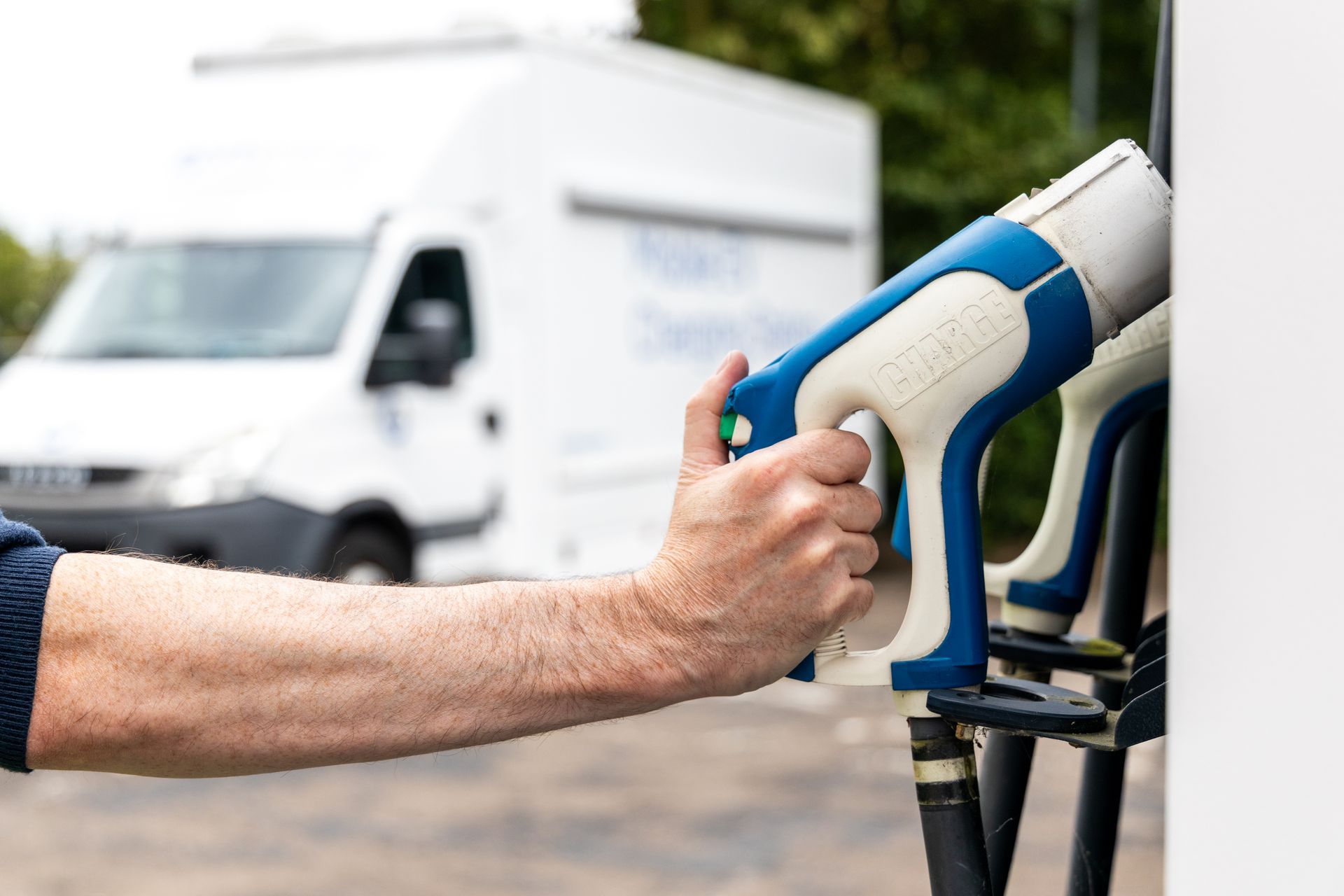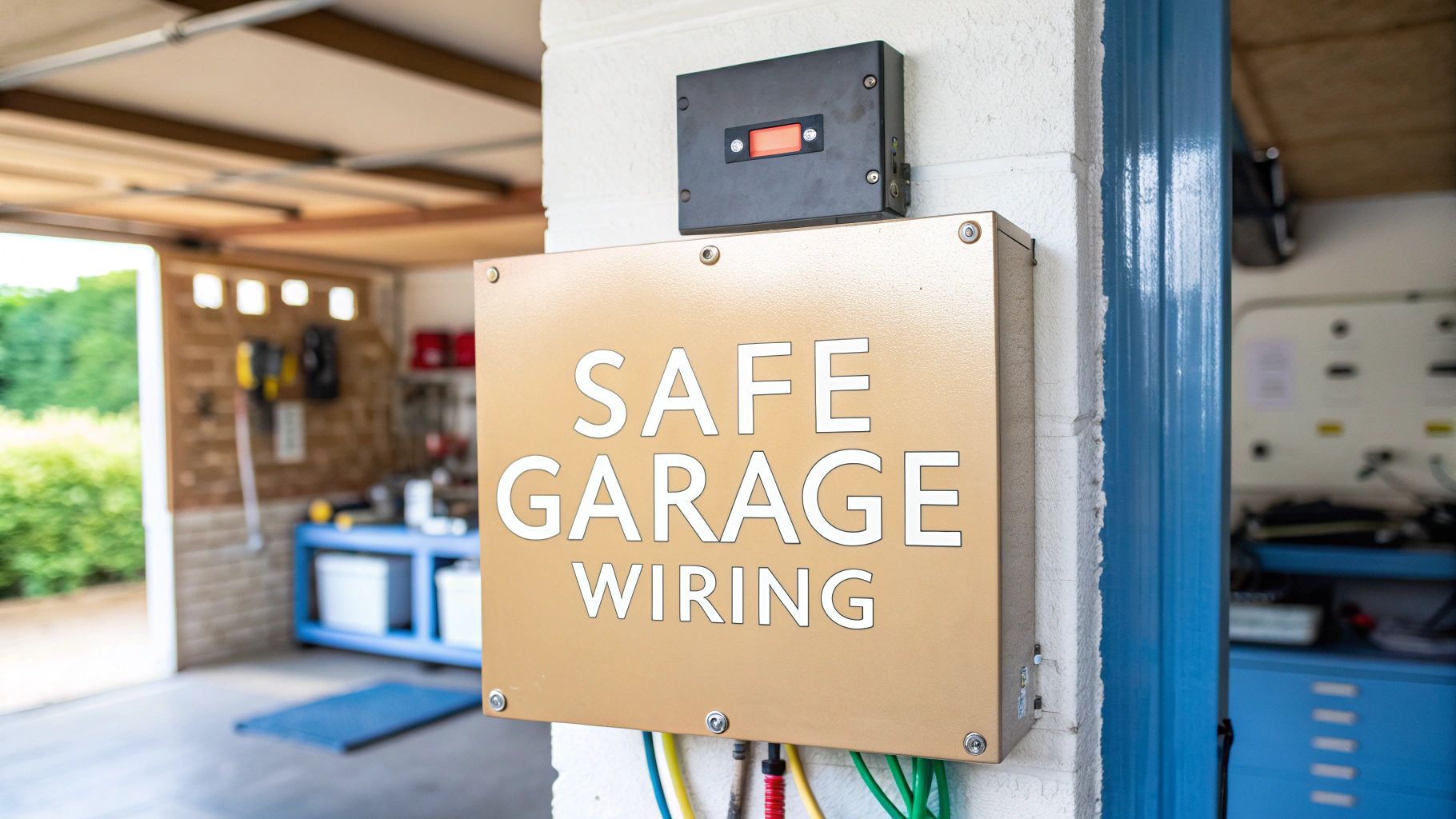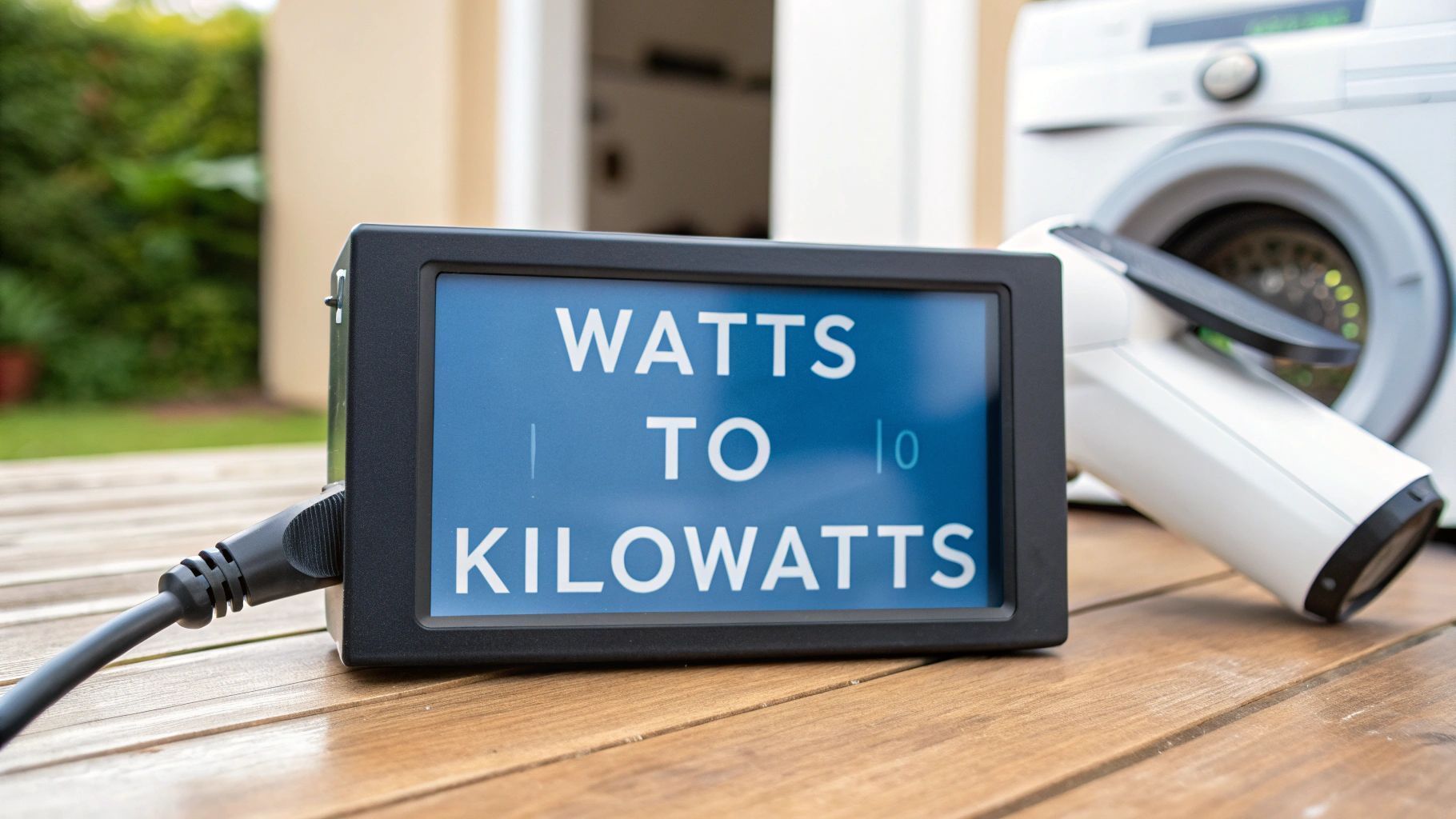How Many Kilowatts to Charge an Electric Car in the UK
The number of kilowatts (kW) you need to charge an electric car really just comes down to one thing: how quickly you need it done.
A slow, convenient top-up at home overnight might only draw 3-7 kW . But if you're on a long journey and need to get back on the road fast, a rapid charger pushing 150 kW or more is what you'll be looking for.
Demystifying Kilowatts and Charging Speeds
It is easy to get bogged down in the jargon, especially with terms like kilowatts (kW) and kilowatt-hours (kWh) thrown around. They sound similar but they measure two completely different things.
Think of it like filling a bucket with water:
- Kilowatt-hours (kWh) are like the size of the bucket . This is your car’s battery capacity—how much energy it can hold.
- Kilowatts (kW) are like the flow rate of the tap . This is the charging speed—how quickly energy is delivered to your battery.
A wider tap (higher kW) fills the bucket faster. It is the same with your EV. A charger with a higher kW rating delivers power more quickly. But there is a catch: the car itself has to be able to handle that speed.
Plugging a car that can only accept 50 kW into a 350 kW ultra-rapid charger will not magically make it charge any faster. It will still only draw power at its maximum rate of 50 kW . Getting your head around this is the key to managing your expectations at the charge point.
For a deeper look at how these units relate, our guide on how to calculate a kilowatt-hour breaks it all down.
To see how this plays out in the real world, here is a quick look at the charger types you’ll find across the UK and what you can expect from them.
EV Charger Types and Typical Charging Speeds
This table gives a rough idea of how charging power translates into time spent waiting.
| Charger Type | Power Output (kW) | Time to Add 100 Miles of Range |
|---|---|---|
| Slow | 3-7 kW | 8-12 hours |
| Fast | 7-22 kW | 3-5 hours |
| Rapid | 50-149 kW | 20-40 minutes |
| Ultra-Rapid | 150+ kW | 10-20 minutes |
As you can see, the right number of kilowatts really depends on your situation. A slow charge is perfect for when you are parked for hours, while a rapid charge is designed for those quick stops on the motorway.
Getting to Grips with EV Charger Power Levels
Understanding the different EV charger power levels is the key to figuring out how many kilowatts you need to charge an electric car in any given situation. Here in the UK, the charging network is split into distinct tiers, each one suited to a different need—from a slow overnight top-up at home to a rapid pit stop on the motorway.
The charger you choose really depends on your context. Are you parked up at home for the night or just grabbing a quick coffee on a long drive? Each scenario calls for a different power level to get the job done efficiently, without you paying for speed you do not actually need.
This diagram shows how charging speed and battery capacity work together to determine how quickly your EV's battery gets filled.
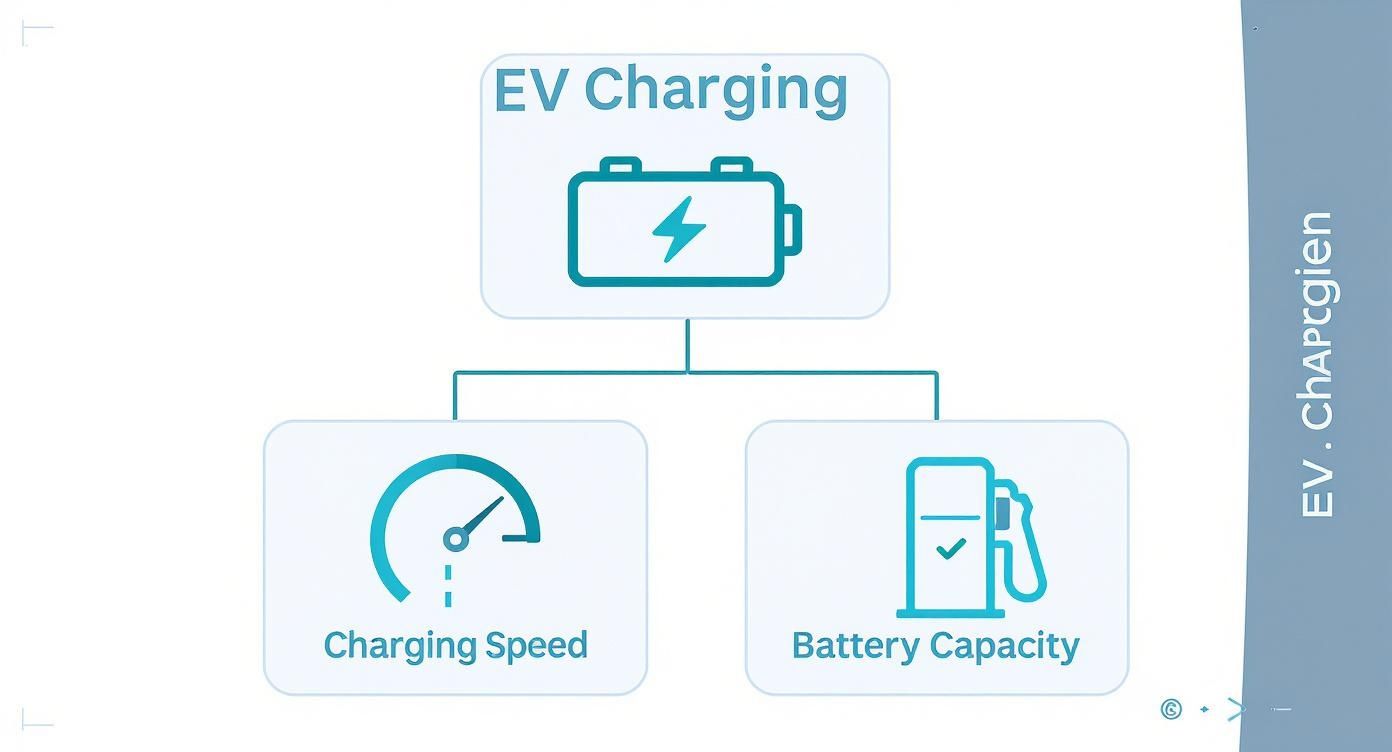
As the infographic shows, getting an effective charge is all about finding the right balance between the charger's output (kW) and your car's battery capacity (kWh).
Common Charger Types in the UK
In the UK, electric vehicle charging power generally falls into four main categories. As of mid-2025, slow chargers below 8 kW make up 55% of all public points, with over 46,000 devices. Fast chargers ( 8-49 kW ) account for roughly 25% with more than 21,000 devices—a number that has shot up by 82% since 2023.
Rapid ( 50-149 kW ) and ultra-rapid ( 150+ kW ) chargers are growing quickly too, with over 16,000 units combined making up the remaining 20% of the network. You can dig deeper into these statistics on Willow Leasing's EV charging report.
So, what do these tiers actually mean for your day-to-day driving?
- Slow Chargers (3–7 kW): These are the units most of us are familiar with for home and some workplace charging. They're perfect for an overnight top-up when time is not an issue, adding around 15-30 miles of range per hour.
- Fast Chargers (7–22 kW): You'll often spot these in public car parks, workplaces and supermarkets. They offer a more substantial boost, with a 22 kW unit adding about 75 miles of range in an hour. Ideal for when you are parked for a few hours.
High-Power Charging for Long Journeys
For drivers covering long distances, rapid and ultra-rapid chargers are an absolute game-changer. These high-power units slash waiting times, making cross-country EV travel practical and a lot less stressful.
A rapid charge is designed to get your battery to 80% as quickly as possible. That final 20% takes much longer to protect the battery’s health, so it is often more efficient to unplug and get back on the road once you hit that mark.
Here is when you will be glad they exist:
- Rapid Chargers (50–149 kW): Typically found at motorway service stations, these can add about 100 miles of range in just 30-40 minutes . They are the real workhorses of the long-distance charging network.
- Ultra-Rapid Chargers (150+ kW): This is the fastest option out there. Depending on your vehicle, ultra-rapid chargers can add 100 miles of range in as little as 10-15 minutes . Perfect for those really quick turnarounds on major routes.
How Vehicle Size Influences Charging Power
The number of kilowatts a charger can push out is only half the story. The other half is all about your car’s own hardware—specifically, its battery capacity and onboard charger. A vehicle's size and design play a huge role in determining how many kilowatts it can actually accept, no matter how powerful the charging station is.
It is not as simple as plugging into the fastest charger you can find and expecting a record-breaking top-up. Every single electric vehicle has a maximum charging rate it can handle. Your car’s Battery Management System (BMS) acts like a gatekeeper, carefully controlling the flow of power to protect the battery’s health and longevity.
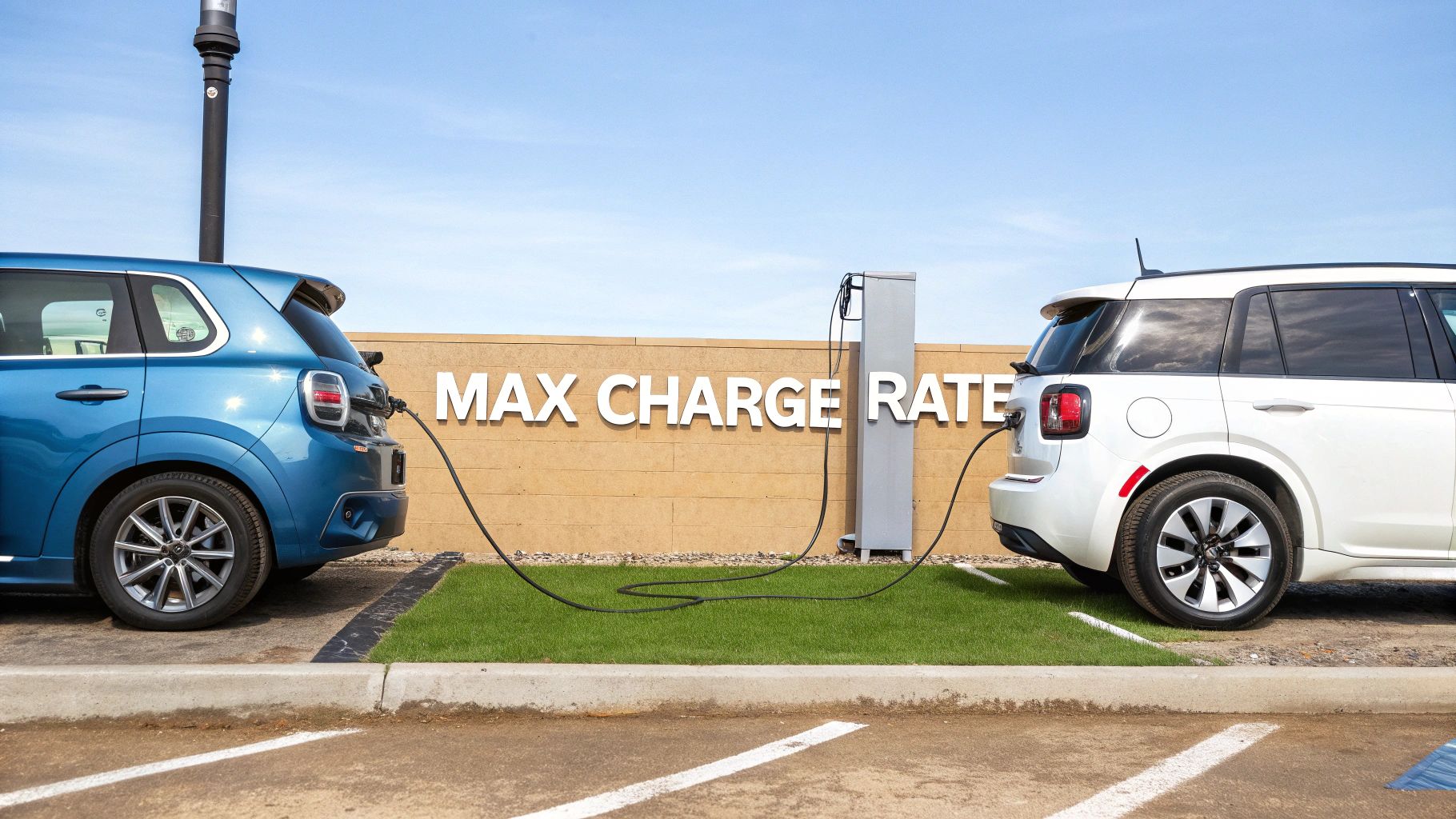
Matching Charger Power to Vehicle Capability
Think about the difference between a compact city runabout and a big, long-range SUV. A smaller vehicle like a Renault Zoe is built for efficiency on shorter trips and might have a maximum DC charging rate of around 50 kW . If you plug it into a 150 kW ultra-rapid charger, it will not speed things up; the car will simply tell the charger to deliver no more than its 50 kW limit.
On the other hand, a larger SUV like an Audi e-tron or a premium saloon is designed for motorway miles and comes with a much bigger battery pack. These vehicles can often accept 150 kW or even more. For them, an ultra-rapid charger is a perfect match, as their systems are built to handle that higher power and slash the time spent at the charge point. Our complete guide to battery packs for car charging in the UK dives into these differences in much more detail.
Understanding the EV Charging Curve
Another piece of the puzzle is what is known as the charging curve. An EV does not charge at a flat, constant speed from empty to full. The rate of charge—the number of kilowatts it is drawing—slows down dramatically as the battery fills up. This is a deliberate safety feature managed by the BMS.
The sweet spot for charging is usually between 20% and 80% . In this window, the battery accepts power at its fastest rate. After 80% , the charging speed drops off sharply to prevent overheating and preserve the long-term health of the battery cells. This is why a quick top-up to 80% is often far more time-efficient than waiting for a full charge.
This curve explains why adding the first 100 miles of range feels so much quicker than adding the last 20 . As battery technology gets better, so does vehicle range. According to the Society of Motor Manufacturers and Traders, the average range of new electric cars in the UK is now nearly 300 miles . Rapid chargers delivering 50 kW can add roughly 150 miles of range in about 30 minutes , while ultra-rapid units push this even further, making long journeys a breeze.
The Perks of Taking Power on the Road

Fixed charging points are the backbone of the EV network but they are not without their headaches. We have all been there: you arrive at a charger only to find every bay is taken or worse, the unit is broken. It is this exact uncertainty that mobile charging solutions are designed to solve, bringing the kilowatts directly to your vehicle, wherever you happen to be.
Instead of hunting for a charger, the charger comes to you. This kind of on-demand service is a game-changer for roadside emergencies, giving a stranded EV driver enough juice to reach the next station or get home safely. It completely flips the script from "where can I find a charger?" to simply "when can I get a charge?".
But the benefits go far beyond just emergency call-outs. Mobile charging offers a genuinely practical answer for all sorts of situations where permanent infrastructure just is not available or does not make sense. This flexibility creates a powerful business opportunity for operators, turning a driver’s inconvenience into a profitable service.
Delivering Power Right Where You Need It
At its core, the main advantage is sheer convenience and accessibility. Mobile units can be rolled out to set up temporary charging facilities at events, on construction sites, or for business fleets that operate far from the public grid.
Just think about the possibilities:
- Events and Festivals: Imagine providing temporary charging banks for thousands of attendees without digging a single trench for permanent cables.
- Fleet Operations: Delivery vans and service vehicles can get a top-up during the day without the downtime of returning to a central depot.
- Residential Complexes: It is a perfect service for residents in apartment blocks or listed buildings where installing personal charge points is a non-starter.
This kind of flexibility means businesses can keep their vehicles on the road and drivers get real peace of mind, knowing a charge is never far away. The UK's public EV charging network is growing fast, with over 82,000 devices expected by mid-2025. Still, mobile solutions are perfect for filling the gaps that even the most robust network will inevitably have. You can explore the official government charging statistics to see just how quickly the landscape is changing.
The Business Case for Going Mobile
For an operator, the financial model is incredibly strong. Mobile charging is a premium service and people are willing to pay for the convenience. An operator can generate revenue from the energy sold (the kWh) but also from the service fee for the call-out itself.
By bringing the charge to the customer, mobile operators can charge a premium for the convenience, turning a driver's problem into a profitable service. This model thrives in emergencies, at exclusive events or for business fleets where vehicle downtime costs far more than a charging fee.
This opens up a seriously lucrative opportunity. Operators can build a business around scheduled fleet top-ups, contracts for events or a 24/7 emergency assistance service, turning every kilowatt delivered into a healthy source of income.
Business Opportunity in Mobile EV Charging
While fixed charging infrastructure is a crucial part of the EV puzzle, the real growth opportunity is in bringing the kilowatts directly to the customer. Mobile EV charging is not just a breakdown service anymore; it is a premium, on-demand solution that opens up some seriously lucrative revenue streams for smart operators.
This model is built on flexibility. It is about delivering power exactly where it is needed, right when it is needed, creating a business built around convenience and genuine customer value. This moves well beyond a simple roadside rescue and taps into markets where permanent chargers are just impractical or simply not there yet. Think of huge outdoor events, sprawling business parks with no charging of their own or even residential blocks where installing charge points is a logistical nightmare.
Identifying Profitable Markets for Mobile Power
The demand for mobile charging comes from a huge range of customers who value convenience and uptime far more than they worry about cost. A savvy operator can build a profitable business by zeroing in on these specific niches and understanding what each is willing to pay.
For instance, a corporate fleet manager is losing money for every minute a delivery van is sitting idle. They will happily pay a premium for an on-the-spot top-up. In the same way, an event organiser can offer EV charging as a high-value perk to attract more attendees.
Here are some of the most promising markets to consider:
- Corporate Fleets: Provide scheduled top-ups for delivery vans, service vehicles or company cars, ensuring they stay on the road without needing to return to a central depot.
- Live Events and Festivals: Set up temporary charging hubs at concerts, sporting events or county shows, charging a premium for the convenience.
- Residential Complexes: Offer a subscription or pay-as-you-go service for residents in apartment buildings where installing private chargers just is not an option.
- Car Rental Companies: Make sure rental EVs are fully charged and ready for the next customer without needing dedicated charging bays at every single branch.
Building the Business Case
The financial model for a mobile charging business is surprisingly strong because you can charge for both the energy delivered and the service itself. This dual revenue stream makes the return on investment incredibly appealing. You set the price per kilowatt-hour (kWh) but you also add a call-out fee or a convenience charge on top.
A mobile charging operator is not just selling electricity; they are selling time, convenience and peace of mind. The premium pricing reflects the value of solving an immediate problem—whether it is a stranded driver or a fleet manager needing to prevent operational downtime.
Let's take a real-world example. An emergency call-out to a stranded driver might involve a £50 call-out fee plus a rate of £0.75 per kWh . Delivering just 20 kWh —enough to provide around 60-80 miles of range—would bring in £65 for a single job. The question of how many kilowatts to charge an electric car in this case is answered by the customer's immediate need: just enough to get them home or to the next fixed charger.
Projecting Potential Revenue
Once you start building a customer base, the earnings can add up fast. How quickly you scale depends on the number of mobile units you have and how efficiently you can schedule them. A single van can comfortably handle several call-outs a day, especially if you are focusing on a dense area or a single large event.
To give you an idea, let us break down what a single mobile charging unit could potentially generate. This table shows how profitability grows based on different daily service volumes.
Hypothetical Monthly Earnings for a Mobile Charger Operator
| Services Per Day | Average Revenue Per Service | Potential Monthly Revenue | Potential Annual Revenue |
|---|---|---|---|
| 2 | £65 | £3,900 | £46,800 |
| 4 | £65 | £7,800 | £93,600 |
| 6 | £65 | £11,700 | £140,400 |
As these figures show, even a modest number of daily call-outs can lead to significant annual revenue. By targeting high-value markets and pricing the service correctly, an investment in a mobile charging unit can deliver a fast and substantial return.
Choosing the Right Charger Power Level
So, how many kilowatts do you actually need to charge an electric car? It all comes down to matching the charger’s power to your specific situation. There is not a single “best” power level; the right choice is about balancing speed, cost and convenience for each charge.
Think of it as picking the right tool for the job. You would not use a sledgehammer to hang a picture frame, would you?
The key thing to remember is the difference between kilowatts (kW) , which measure charging speed, and kilowatt-hours (kWh) , which measure battery capacity. A 7 kW home charger is perfect for overnight top-ups when you have got plenty of time. But a 150 kW rapid charger is exactly what you need for a quick boost on a long motorway journey. Getting this distinction right stops you from overpaying for speed you simply do not need.
Finding Your Ideal Kilowatt Level
Your daily routine is the best guide to your power needs. Let us look at a few common scenarios to help you find your match:
- Home Charging (3-7 kW): This is the sweet spot for overnight use. Just plug in when you get home and wake up to a full battery. Our complete guide to charging a car battery at home in the UK breaks down this entire setup in more detail.
- Workplace or Destination Charging (7-22 kW): A great option for topping up while you are parked for a few hours at the office, the gym or the supermarket.
- Public Rapid Charging (50-150+ kW): This is for long-distance travel, where getting back on the road as quickly as possible is the number one priority.
- Mobile Charging Services (Flexible kW): This is the ultimate convenience. It is perfect for emergencies, events or any location without fixed chargers, bringing the power directly to you.
Choosing the right power level does not just save you time and money. It also helps preserve your vehicle's long-term battery health by avoiding unnecessary high-speed charging when it is not needed.
And a quick word of advice: for any fixed charger installation, especially the more powerful ones, it is absolutely crucial to consult with qualified electrical contractors. They can make sure your property's wiring can handle the load safely.
FAQ
We get asked a lot of questions about what different kilowatt ratings mean for charging an electric car. Here are a few of the most common ones, answered in plain English.
How Long Does It Take to Charge an EV With a 50 kW Charger?
A 50 kW rapid charger is a common sight and can typically add around 100 miles of range in 30-40 minutes . The exact time, of course, depends on your car’s battery size and how full it is when you plug in.
Here is a rough way to think about it. Imagine your EV has a 60 kWh battery and you pull up with 20% charge. To get to 80% , you need to add 60% of its capacity, which works out to 36 kWh . Divide that 36 kWh by the charger's 50 kW power and you get 0.72 hours —or about 43 minutes .
Will Using Ultra-Rapid Chargers Harm My Battery?
Using an ultra-rapid charger every now and then is perfectly fine. That is exactly what they are designed for—getting you back on the road quickly during a long journey.
However, if you only use high-power DC chargers, it can speed up battery degradation over time. For the best long-term battery health, it is a good idea to mix in slower AC charging sessions at home or work when you can.
Can a Mobile Charger Support a Long Journey?
Absolutely. A mobile charger is an invaluable tool for a long trip, especially if you run into an out-of-service public charger or realise you are not quite going to make it to your destination.
A mobile charging unit can quickly deliver 10-20 kWh of power, providing an additional 30-60 miles of range. This is often more than enough to get you safely to the next rapid charging hub or all the way home, completely eliminating range anxiety.
This on-demand power makes them an essential safety net for any EV driver.
For a flexible and reliable charging solution that comes directly to you, discover how ZAPME can help. Our mobile units provide the power you need, right where you need it. Visit us at https://www.zapme.biz.

